So you want to be a bicycle mechanic. BicycleThailand.com is here to help you recognize just what is needed in order to complete your transformation into ‘Bicycle Repairman’. Far more than just a bottle of chain lube and a BFH is needed to get you successfully wrenching on your bicycle at home. This list of 11 must-have items is a great starting point for any aspiring home mechanic. With these 11 items you’ll be equipped to handle most cleaning and maintenance procedures on your bicycle. In addition, having these 11 items will allow you to easily tackle many basic repairs associated with the normal use of your bicycle.
1. Repair stand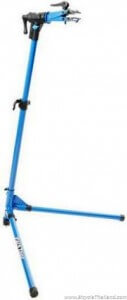
Getting the bicycle up and off the ground so that the gears, brakes, wheels, and chain drive can be easily checked is essential to properly assessing a problem without the hindrance associated with holding the bicycle yourself or flipping it upside down (making access to the gear and shift levers difficult). When the first bicycle repair stands came out they were expensive and heavy. The high cost kept them out of most home mechanic’s reach while the heavy design made them a rare sight at races and group rides. But today many companies offer collapsible and ‘home mechanic’ models specifically targeted to race mechanics and do-it-yourself minded home mechanics. Check out what top bicycle tool companies like Park Tool and Pedro’s have to offer. Avoid repair stands from unreliable or unknown companies. If cost is still an issue, consider some of these great ‘build your own’ options.
Weekend Project: Bicycle Repair Stand
Ultra Cheap Bicycle Repair Stand
Make a Hanging Bicycle Repair Stand
2. Floor pump
Regardless of the brand, color, or size there are three very important things you should be looking for in a good quality floor pump:
1. It is made of metal. Do not buy a plastic floor pump. the idea here is that this floor pump is for your home use, not to be taken on the bicycle and not to be transported around in your luggage. So, weight and size is NOT important. Go big (more capacity means less work for you), go metal (steel, aluminum, or unobtanium, it doesn’t matter as long as it is METAL), and go durable (thick rubber air hose with a tough air chuck, and a strong handle).
2. It has a built-in air gauge. Why bother with having an air pump AND a separate air gauge tool? Better to have them in the same tool. If you have a floor pump with a built-in gauge it will cause you to more accurately keep track of tire pressure and it will actually encourage you to check your tires more frequently.
3. It has the ability to inflate Presta (PV/FV) AND Schrader (SV/AV) valve tubes. Don’t bother purchasing a floor pump that doesn’t do both. Even if your bicycle has one type of valve and you can’t see any reason for needing the other, believe me, you WILL need the other type some day and you’ll kick yourself for not buying the floor pump that does both.
3. Chain cleaning system
Keeping a clean chain is paramount to drivetrain longevity. After a particularly nasty ride clean your chain, let it dry, and then apply chain lubricant. Read more tips and procedures for cleaning your bicycle chain here. Every home mechanic should have a chain cleaning system, degreasing solvent, and chain lubricant. Chain cleaning systems, degreasers, and lubricants are all available from bicycle tool manufacturers like Park Tool, Pedro’s, Finish Line, IceToolz, and Birzman.
4. Metric hex wrench set
The MOST common size of hex bolt found on every make and model of bicycle being manufactured today is the 5 millimeter. I suggest that every mechanic has an entire set of hex wrenches (sizes: 2.5-10mm) on their workbench or in their tool pouch. Most professional mechanics have a full set of hex wrenches with multiple lengths and configurations (short, long, and T-handle) in the 5 millimeter size to help them get into difficult areas of the bike frame. These different lengths and configurations become especially useful on the rear linkage systems of full-suspension mountain bikes. You don’t need to buy the fancy color-handled hex wrench sets from the bicycle tool manufacturers in order to get top quality. You can pick up a good set at any hardware or home improvement store.
5. Pedal wrench
You have to have one, end of story. While I see many home mechanics using 15 millimeter open-end wrenches to remove and install bicycle pedals, the short handles of these type of wrenches do not give much leverage to the user when attempting to remove stubborn pedals from a crankarm. If you can afford only one pedal wrench, purchase the biggest baddest one you can find. Length of arm (longer means more leverage) and dual pedal size (9/16″ and 15mm) are the two main features you should be looking for in a pedal wrench. If you can splurge and want to add a second pedal wrench to your tool lineup look for one slightly smaller in size (for travel/transport purposes) with a rubber-coated handle (this will help make up for the loss of leverage due to smaller size) and a single pedal size option (15mm or whatever your specific bicycle needs).
6. Phillips head screwdriver
Necessary for adjusting front and rear derailleur set screws, cable dust cover caps, cable guides, and some brake lever reach dials. Two different sizes (#1 and #2) will cover most machine screws that you will come across while working on bicycles. Choose a brand that offers a good quality tip material. It is important to keep the head of the screwdriver clean from metal shavings and other debris. NEVER use your screwdriver as a punch, scribe, or cleaning tool.
7. Cable cutters
All cable replacement jobs will require the smooth and accurate cut of a pair of top-quality bicycle cable cutters. DO NOT substitute off-the-shelf angle blade cutters for this unique tool. Get your hands on cutters from bicycle parts manufacturers like SHIMANO or bicycle tool suppliers like Park Tool.
8. Chain tool
Every mechanic needs to have the ability to replace chain connecting rivets, size and install new chains, and work out annoying tight links. Having a good chain tool that can handle all of that and do it on a variety of chain types (8-10 speed Campagnolo, Shimano, and all compatible chains) is essential to correcting drivetrain issues that require some chain love.
9. Rubber mallet
Here is another tool that, much like the hex wrench set, does not need to come from a bicycle tool company. What you need is a medium sized mallet, preferably with a wooden handle. This mallet is going to come in handy when you are installing or removing parts from your bicycle that need a bit of mobster-style ‘convincing’ to get them to move. Using a metal hammer will definitely get faster results but you run the chance of marring the surface of your new part. Likewise, striking some parts of your bicycle (i.e. the steerer tube on your fork) with a metal hammer could cause beveling on surfaces that need to remain round to allow other parts (headtube spacers and handlebar stem) to fit over them.
10. Metric ruler
You WILL be surprised how often you use this once you put it in your tool box. How long is that stem? What size is that bolt? How far apart are the grips from the gear shifters?
Having a small metal metric ruler in your possession will help you answer all of those questions AND it will make you a better mechanic. How will such a little thing make you a better mechanic? By causing you to take accurate measurements, to learn industry standards, and to recognize when something just doesn’t add up. Also, when replacing parts it’s always great to bring the old one down to the bike shop with you to help locate a suitable replacement, but what if you don’t have the old part? What do you do? Simply, pull out your ruler and measure something on the bike that indicates what used to be there. Here’s an example: Guy at the bike shop asks if your old Shimano bottom bracket is a 68 or a 73 but you don’t have the old one to show him. What to do, what to do? Put that little metal metric ruler across the underside of your bicycle’s bottom bracket and you’ll quickly know if your bicycle uses a 68 millimeter or a 73 millimeter size bottom bracket. Here’s another one for you: What size spoke do you need? Measure the spoke that is still in the wheel one hole over from the one that is broken/missing. I usually find the best rulers in stationary shops but have seen them in hardware and home improvement stores as well. Metal is preferred because wooden rulers tend to get nasty after soaking up solvents and grease from living in your tool box. Etched numbers and marks are better than ones that have been painted on to the ruler because solvents in your tool box could eventually erase these.
11. Tire levers
Strong and plastic is what you are looking for here. If you spend any amount of time riding and wrenching you will find a brand that works best for you. To avoid tire and rim damage/marring DO NOT use anything other than bicycle tire levers to unseat a tire from its rim. Every mechanic has several tire levers in his tool kit because even the best ones will break after frequent use.
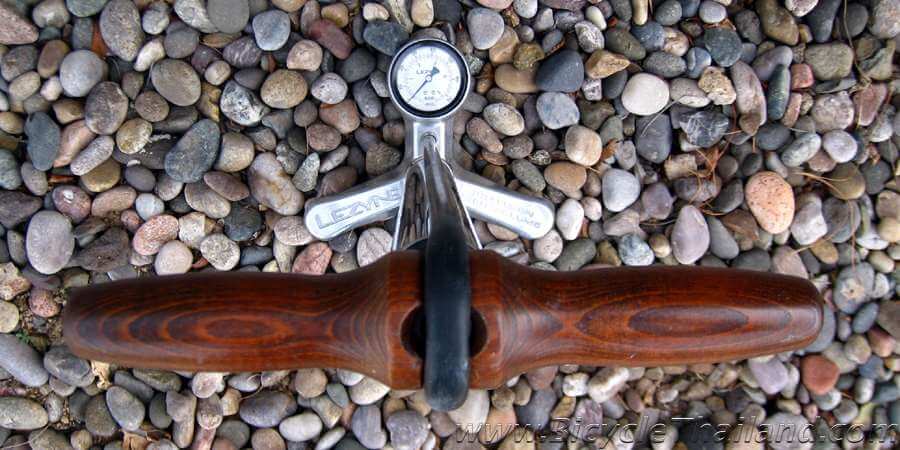

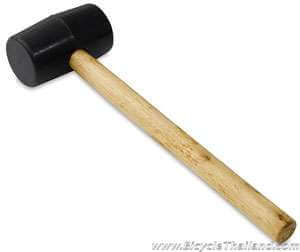
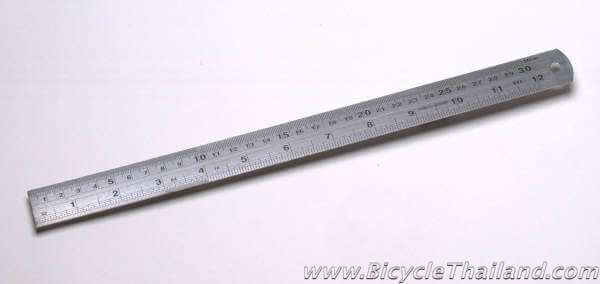
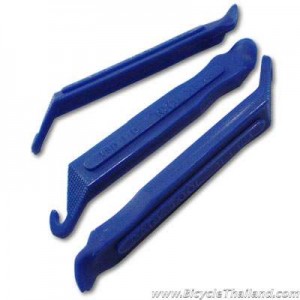
Leave a Reply